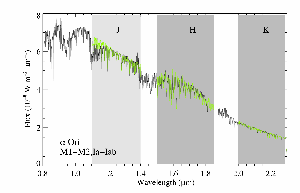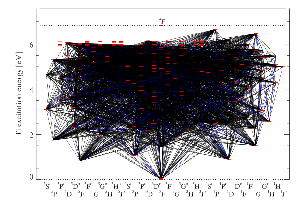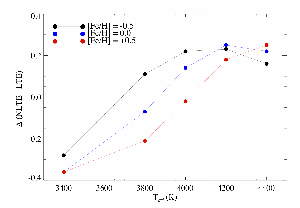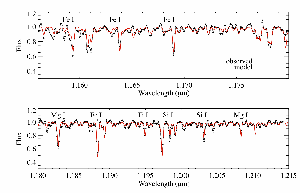|
|  |
Chemical composition is one of the key observable characteristics of
star forming galaxies in the nearby and in the high redshift
universe. So far, most of our information about their metal content
(astrophysicists summarise all elements heavier than helium as
"metals") has been obtained from the analysis of strong emission lines
from H II regions, i.e. low-density clouds of partly ionised hydrogen
gas. However, measurements of galaxy metallicities are then uncertain
by a large factor because of the systematic uncertainties inherent in
this 'strong-line' method. Furthermore, the method yields basically
only the oxygen abundance, which is then taken as a placeholder for
the overall metallicity. In this case, there is no information on
abundance ratios, which can be a powerful diagnostic of the chemical
enrichment history.
An alternative approach avoiding these weaknesses is the spectroscopic
analysis of supergiant stars, the brightest stars in galaxies with
luminosities up to one million times brighter than the Sun. Here,
much progress has been made through the optical spectroscopy of blue
supergiants in the Milky Way (Fig. 1) and few other galaxies of the
Local group. For extragalactic astrophysics, however, red supergiants
(RSGs) are more promising candidates. Their spectral energy
distribution peaks in the infrared, where interstellar extinction is
reduced. Particularly attractive for quantitative spectroscopy is the
J-band (Fig. 2), which contains many isolated atomic lines. Spatial
resolution in the infrared is also higher than in the optical and the
advantage of instruments supported by adaptive optics can be fully
exploited. RSGs are therefore ideal targets for spectroscopy with
future telescope facilities, such as the Thirty Meter Telescope (TMT)
and the European Extremely Large Telescope (E-ELT). The abundances of
various chemical elements could be then directly measured out to
distances of 70 Mpc, far beyond our Local Group of galaxies.
The analysis of RSG spectra, however, is a challenging task.
One major complexity arises due to very low gravities (about 1000
times less than on Earth), stipulating departures from Local
Thermodynamic Equilibrium (LTE) in their photospheres. Until now, it
has not been possible to compute RSG spectra in non-LTE, as one would
need detailed atomic data for constructing the non-LTE atomic models
and to model the complex line blanketing, which is dominated by
molecules. So far, the atomic data was of insufficient
quality. Furthermore, while in LTE the line formation calculation are
fairly simple, in the non-LTE case, accurate radiative
intensities must be computed at all frequencies where radiative transitions
occur in an atom. For iron and titanium this means for wavelengths from UV
to far-IR. Such calculations were simply beyond the computational
power so far.
The team of scientists has now constructed complete atomic models of neutral
iron and titanium (Fig. 3) and performed, for the first time, non-LTE
calculations of these atoms using model atmospheres representative of RSG
stars. The inclusion of non-LTE effects changes the titanium abundances
dramatically compared to LTE and with different correction factors for
different temperatures and metallicities (Fig. 4). However, the
non-LTE effects on the J-band iron lines are much smaller. Since the
RSG metallicity is determined from many lines of different atomic
species (iron, titanium, silicon and magnesium), the overall effect of
non-LTE corrections may not be as large as for titanium alone. For
example, the best non-LTE fit to the J-band spectra of Betelgeuse
is shown in Fig. 5.
The next step therefore will be to model the other prominent species in the
J-band spectral window, namely silicon and magnesium. These lines also
contain important metallicity information, since together with Ti they provide
additional constraints on the measurement of a galactic abundances of alpha-elements,
i.e. elements produced by fusion of alpha-particles.
Maria Bergemann (MPA), Rolf Peter Kudritzki (IfA, Hawaii/MPA), Karin Lind (MPA)
References
Bergemann, Kudritzki, et al. 2012, ApJ, in prep.
Kudritzki, Urbaneja, Gazak et al. 2012, ApJ, 747, 15
Davies, Kudritzki, Figer 2010, MNRAS, 407, 1203
Gieren, Pietrzynski, Bresolin, Kudritzki et al. 2005, ESO Messenger, No.121, p. 23-28
Cushing, M.C., Rayner, J.T, & Vacca, W.D. 2005, ApJ, 623, 1115
Rayner, J.T., Cushing, M.C., & Vacca, W.D. 2009, ApJS, 185, 289
|






